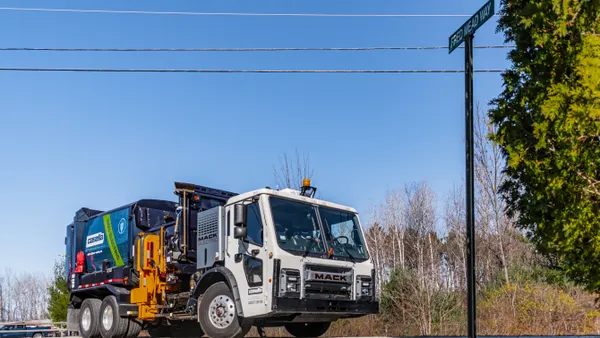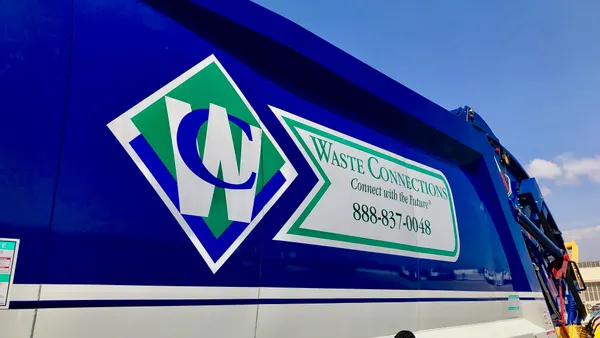Safety remains one of the most pressing topics for operators of all size in the waste and recycling world. Now, the private side of the industry has a new voice in this national discussion.
Last month, Kirk Sander was named vice president of safety and standards for the National Waste & Recycling Association. Most recently he worked at the National Safety Council following stints at OSHA, NASA, the Department of the Interior and the White House. This hire marks the latest in a series of staffing changes by NWRA President & CEO Darrell Smith, and is technically the combination of two previous positions.
Smith, upon starting his own tenure last year, told Waste Dive that "safety is in my blood" and has been vocal about clarifying the private sector's role in the ongoing dialogue to improve conditions industrywide. Sander enters at a busy time, as all involved continue working to get waste collection off the list of most dangerous occupations, respond to the evolution of technology and ensure workers receive proper training.
The following interview has been edited for brevity and clarity.
WASTE DIVE: Since this is a new position, how would you describe the role? How should people think about the job you're going to be doing at NWRA?
KIRK SANDER: They should really think about it as a bridge from safety and policy. What's happening in the field is also affected by what's being decided in Washington. So navigating FMCSA, DOT, OSHA ... and then also providing good stories and good data from the field into those agencies so that we have good public policy.
Based on your initial read of the industry, what are some areas of opportunity you see in terms of creating a better narrative and better communication with those agencies?
SANDER: Being that it's day seven, that's what I'm trying to get my head around and understand. We really want to get off the top five most dangerous jobs. [I'll be] trying to figure out where the best wins are so that we can get off that list, by first establishing what that baseline of data looks like.
When you were at OSHA, were there any good examples of other industries that had similar safety challenges that you thought were doing good collaborations, or any other best practices that could translate over?
SANDER: The STEPS Network was really good ... It's the oil and gas industry, and they really worked collaboratively with OSHA to figure out what was going on. So I think that's one model of how do you work with OSHA and NIOSH to find the best ways to improve, to build a safety culture and build a safety management system that works for your industry.
Speaking as someone who used to be on the other side, what message would you give people in the industry that may be hesitant to deal with OSHA or keep the agency at arms length?
SANDER: I think communication is always key ... Our joking tagline for OSHA was, "nail salons to nail guns." So if you think about what an OSHA inspector in a month could encounter, you want to have those conversations with OSHA so they recognize your industry and they understand the uniqueness of your industry, and they're not getting it confused with another industry.
The role of temp workers have been an ongoing topic in the industry recently. Do you have any concerns about safety training for temp workers? If companies are going to utilize staffing agencies, what should they be doing to make sure those workers are as safe as their regular employees?
SANDER: I think this gets back to us wanting to build relationships with OSHA. They've been pushing and have a temp worker initiative. They have a partnership with my most recent employer, the National Safety Council and the American Staffing Association. [The two] will go out and look at, and give a sign of distinction to, staffing associations that have good safety programs. So I think working with organizations like that, that have in place good temp worker practices, will help to better the industry.
Technology has been another big topic in recent years, from cameras in truck cabs to automated collections arms or other advancements that limit exposure to hazards. What are your general thoughts on the role of technology as it relates to safety and how you may approach it in the new job?
SANDER: I think technology can always bring a benefit. One of the things you always have to watch out for are unanticipated risks and opportunities. Any time that you remove a person from a hazard, that's a good thing.
Not only automatic collection, but I think with where U.S. DOT's moving as they start building the basis for autonomous vehicles, we need all to be on the lookout for what those regulations are going to say — if they move more into the truck regulations.
Recognizing that it's still very early, what are your general goals for the job? What do you hope to bring to the organization and what should people expect to see you working on?
SANDER: I want to help raise the profile of NWRA so that when people look at their trash can, they understand what goes behind that. That they know that the person who's collecting it is going to collect it safely and can go home to their family — just as they probably are rushing out the door to get the can or container out, or the trash bag in the bin, so that they can get their kid off to daycare — that they know that the person who's going to pick that up is also going to be able to go home and see their kid.
What is a good way to get people to care more about the workers? Is it just general awareness about what the job entails and what happens after the curb?
SANDER: Yeah, I think it's getting out there, and you're going to see me out there. I already have a travel schedule for the next month on the East Coast and at a couple of other meetings. So I'm looking forward to being in the industry and then getting out and about.











